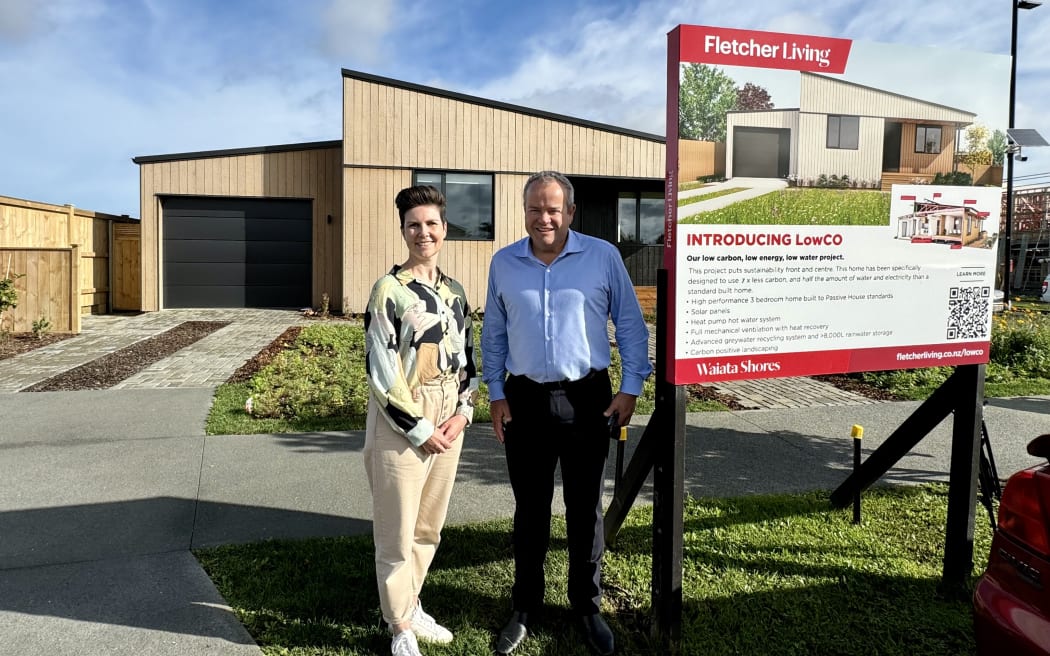Nicola Tagiston and Steve Evans from Fletcher Living outside the South Auckland home that achieved the highest possible climate-friendly rating.
Photo: Supplied
A three bedroom, two bathroom home in South Auckland has achieved the highest possible climate-friendly rating, one of the first family-sized homes to achieve that level of sustainability.
The 10 Homestar-rated house was built in response to research showing the average new home emits seven times as much carbon dioxide as it can afford to, if the world is to stay inside 1.5 degrees celsius of global heating.
A 2020 study by Massey University and the Building Research Association of New Zealand found the typical new home needed to shrink its carbon dioxide emissions from construction and running, over a 90-year lifespan, by at least 80 percent to be compatible with world climate change goals.
Steve Evans of Fletcher Residential and Development said his company designed the new three-bedroom house with that target in mind, with the home successfully coming in at seven times lower carbon than a standard new build.
“Our industry has to change,” he says.
The house took three years to research and build.
A three-unit terraced home next door achieved the same level of carbon savings.
The standalone home has timber piles and a low-carbon concrete driveway, and an induction cooktop, which produces lower emissions than gas.
A hot water heat pump uses 30 percent of a typical cylinder’s electricity, while insulation and the design of the framing keeps cold out, and a ventilation system lets fresh air in.
Fletcher Living head of sustainability Nicola Tagiston said the house trapped most of its own rain water, stored in tanks under the floors, although it was also connected to water mains.
Windows are double-glazed – Auckland’s climate did not justify triple-glazing, she said.
There are solar panels on the roof, but Tagiston said these were optional, because of New Zealand’s mainly-renewable – and getting more renewable – power grid.
The home will be monitored for three years to test its energy efficiency.
The designed – called LowCo – does cost more to build.
Evans said the added upfront cost would be about 5 to 10 percent above a normal build, which was more than outweighed by lower power and water bills.
Evans said Fletchers would start incorporating some of the low-carbon features into standard housing developments, though he was not sure which ones yet.
Eventually he said fully low-carbon builds will reach cost parity with standards homes, “and we’ll just do it”.
Another South Auckland development – Kainga Ora’s Bader Ventura development of 18 apartments – was finished last year and is estimated to have made power bills 85 percent cheaper for tenants than a standard home, costing about a dollar a day to run.
Low cost alternatives
For those not building new properties, Auckland Council low carbon specialist Liz Ross said people can shrink their power bills with cheap alterations such as changing to efficient shower heads or applying perspex sheets to the windows – a low cost, but “tidy-looking” alternative to double glazing.
Ross said single-glazed windows will be a big source of heat loss for most older homes, but thermal blinds or even bubble wrap on the windows could help.
Changing a lightbulb to LED was not a huge carbon saving on its own, but had great bang-for-buck because a $5 investment can save $100-300 in power bills, she said.
Airing a home by opening windows for 10-20 minutes twice a day helped remove damp and make the house warmer, she said – an exercise she called a “burnt toast blast”.
Ross said efficient shower heads had air jets, so people “feel like they’re getting a good shower”, despite using less water.
“We recommend people do a bucket test to test their flow rate.”
If a standard 10-litre bucket filled up in less than a minute, people might consider replacing the shower head, she said.
“The average is about 12 litres a minute and some houses have up to 16 which uses a lot of energy.”
Larger changes – such as adding insulation in the walls or replacing the hot water cylinder – could be done when people were renovating, or appliances reached the end of their lives and could be replaced with more efficient ones, said Ross.
She recommended that people check if they were eligible for subsidies, especially gold card or community service card holders, and said some banks offered loans at 1 percent interest for insulation, double-glazing and heat pumps.
>>> Read full article>>>
Copyright for syndicated content belongs to the linked Source : RNZ – https://www.rnz.co.nz/news/national/514967/our-industry-has-to-change-south-auckland-home-gets-top-climate-friendly-rating































